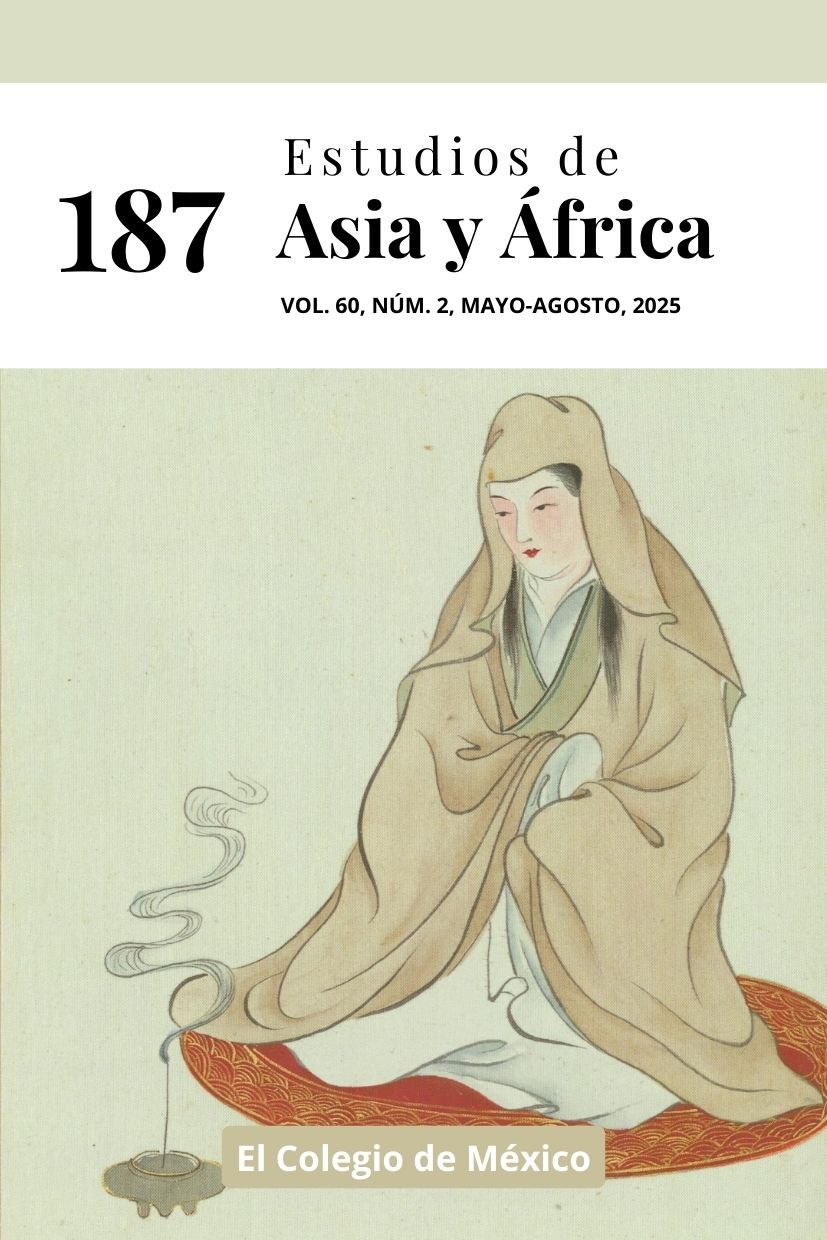Abstract
This paper presents an investigation of the reception of female roles in Dream of the Red Chamber, a masterpiece of Chinese literature. First, we highlight that the novel reflects the traditions of classical Chinese society. Second, we explain the findings based on Jauss’s horizon of expectations theoretical framework and Hymes’s SPEAKING model methodology, and explain the respondent selection process. Third, we show the findings: women’s roles are influenced by the social structure, and norm compliance facilitates goal attainments. Fourth, we show conclusions that, although the partly depart from our initial hypothesis, partly coincide with the hypotheses and methodological approaches that other scholars have made to the novel.
References
Amate Núñez, Patricia. 2024. “Sociedad, género y cultura. Análisis sociolingüístico de la novela Sueño en el Pabellón Rojo (紅樓夢)”. Tesis de doctorado, Universidad de Almería.
Brown, Kerry y Jin Xin. 2018. “How Reading ‘The Dream of the Red Mansions’ 《红楼梦》
Can Help Understand China Today”. Kerry Brown Reviews, 30 de junio de 2018. https://bkerrychina.com/2018/06/30/how-reading-the-dream-of-the-red-mansions-%E3%80%8A%E7%BA%A2%E6%A5%BC%E6%A2%A6%E3%80%8Bcan-help-understand-china-today/
Cai Yuanpei 蔡元培. (1917) 2008. Shitou ji suo yin《石头记索隐》[Interpretación histórica de Sueño en el pabellón rojo]. Shanghái: Shanghai Century Publishing Group.
Cao Xueqin. (1791) 2009. Sueño en el pabellón rojo. Traducido por Zhao Zhenjiang y José Antonio García Sánchez. Barcelona: Círculo de Lectores.
Chang Hsin-chih. (1884) 1990. “Chang Hsin-chih on How to Read the Hung-lou-meng (Dream of the Red Chamber)”. En How to Read the Chinese Novel, editado por David L. Rolston y traducido por Andrew Henry Plaks, 316-323. Nueva Jersey: Princeton University Press.
Du Jinhuan 杜瑾焕. 2014. “Xue Baochai renge jiegou de fuhao xue chanshi” 薛宝钗人格结构的符号学阐释 [Interpretación semiótica de la personalidad de Xue Baochai]. Journal of Henan University of Science and Technology (Social Science) 32 (6): 45-49. https://caod.oriprobe.com/articles/45056223/A_Semiotic_Interpretation_on_the_Personality_Structure_of_Xue_Baochai_.htm
Edwards, Louise. 1993. “Representations of Women and Social Power in Eighteenth Century China: The Case of Wang Xifeng”. Late Imperial China 14 (1): 34-59. https://dx.doi.org/10.1353/late.1993.0009
Guan Qiaozhong 管乔中 y Huang Zhihong 黄志鸿. 2017. “《Hong lou meng》 Renwu xingxiang yanjiu ——Miaoyu pian” 《红楼梦》人物形象研究 ——妙玉篇 [Estudio de los personajes de Sueño en el pabellón rojo: Miaoyu]. Journal of Hanshan Normal University 38 (1): 38-44.
Hernández Sampieri, Roberto, dir. 2014. Metodología de la investigación}. 6a. ed. México: McGraw-Hill.
Hymes, Dell. 1974. Foundations in Sociolinguistics: An Ethnographic Approach. Nueva York: Tavistock.
Jauss, Hans Robert. 2004. “Literary History as a Challenge to Literary Theory”. En Literature in the Modern World. Critical Essays and Documents, editado por Dennis Walder. Oxford: Oxford University Press.
Jia Yujia 贾玉嘉. 2011. “Xue Baochai huayu jiaoji zhong de limao yuanze fenxi” 薛宝钗话语交际中的礼貌原则分析 [Análisis del principio de cortesía en la comunicación discursiva de Xue Baochai]. Journal of Taiyuan Normal University (Social Science Edition) 10 (1): 107-109.
Jung, Carl Gustav. 2014. Psychology and Religion: West and East. Vol. 11 de The Collected Works of C.G. Jung: Revised and Expanded Complete Digital Edition, editado por Gerhard Adler, Michael Fordham y William McGuire, y traducido por Richard Francis Carrington Hull. Princeton: Princeton University Press.
Kinney, Anne Behnke. 2014. “Introduction”. En Exemplary Women of Early China: The Lienü zhuan of Liu Xiang, editado y traducido por Anne Behnke Kinney, xviii. Nueva York: Columbia University Press.
Luo, Chuanwei 骆传伟. 2011. “Piping xing huayu fenxi moxing xia renwu shenfen yu xianghu guanxi de jiangou—— yi《Hong lou meng》zhong Wang Xifeng yu Liu Laolao chuci jian mian de duihua wei li” 批评性话语分析模型下人物身份与相互关系的建构——以《红楼梦》中王熙凤与刘姥姥初次见面的对话为例 [La construcción de la identidad y las interrelaciones de los personajes bajo un modelo de análisis crítico del discurso: primer diálogo entre Wang Xifeng y Liu Laolao como ejemplo en Sueño en el pabellón rojo]. Journal of Ningbo Institute of Education 13 (5): 68-72.
Peng Youming 彭有明 y Cao Xiaoxia 曹晓霞. 2010. “Cong shunying lun kan Liu Laolao de yuyan yishu” 从顺应论看刘姥姥的语言艺术 [El arte del lenguaje en la teoría de la conformidad de Liu Lao Lao]. Journal of Nanyang Institute of Technology 2 (5): 1-5. https://d.wanfangdata.com.cn/periodical/nylgxyxb201005001
Schonebaum, Andrew y Tina Lu, eds. 2012. Approaches to Teaching the Story of the Stone (Dream of the Red Chamber). Nueva York: Modern Language Association of America.
Wan Hongzhen万洪珍. 2012. “《Hong lou meng》zhong Jia Mu de mu shen yuanxing tanxi”《红楼梦》中贾母的母神原型探析 [Exploración de Jia Mu como arquetipo de Nüwa en Sueño en el pabellón rojo]. Journal of Huaihai Institute of Technology (Humanities & Social Sciences edition) 10 (17): 66-68. https://www.doc88.com/p-1364625423523.html
Wang Guowei 王國維. (1904) 2012. Hongloumeng pinglun《紅樓夢》評論 [Comentario sobre Sueño en el pabellón rojo]. Hangzhou: Zhejiang Guji.
Wang Xiaojue. 2012. “Stone in Modern China”. En Approaches to Teaching the Story of the Stone (Dream of the Red Chamber), editado por Andrew Schonebaum y Tina Lu, 413-426. Nueva York: Modern Language Association of America.
Widmer, Ellen. 2006. The Beauty and the Book: Women and Fiction in Nineteenth-Century China. Cambridge: Harvard University Press.
Yang, Lihui, Dening An y Jessica Anderson Turner. 2008. “Nüwa”. En Handbook of Chinese Mythology, 170-176. Nueva York: Oxford University Press.
Yi Guo. 2017. “The Circulation of a Chinese Classic—A Dream of Red Mansions in Western Countries”. Tesis de máster, Universidad de Utrecht.
Yu Pingbo 俞平伯. (1952) 1988. Yu Pingbo lun honglou meng 俞平伯論紅樓夢 [Discursos sobre Sueño en el pabellón rojo]. Shanghái: Shanghai Guyi.
Zhao Xingqin 赵兴勤. 2008. “Wang Xifeng xingge nei yun de wenhua jiedu” 王熙凤性格内蕴的文化解读 [Interpretación cultural del carácter de Wang Xifeng]. Journal of Hechi University 28 (6): 24-29. https://d.wanfangdata.com.cn/periodical/hcszxb200806005
This work is licensed under a Creative Commons Attribution-NonCommercial-NoDerivatives 4.0 International License
Copyright 2022 Estudios de Asia y África



